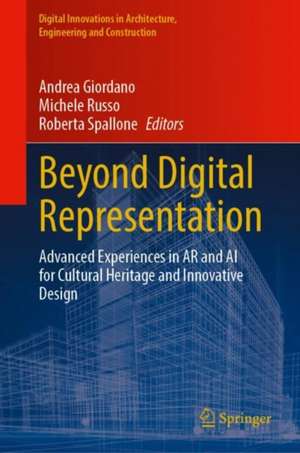Beyond Digital Representation: Advanced Experiences in AR and AI for Cultural Heritage and Innovative Design: Digital Innovations in Architecture, Engineering and Construction
Editat de Andrea Giordano, Michele Russo, Roberta Spalloneen Limba Engleză Hardback – 2 sep 2023
Din seria Digital Innovations in Architecture, Engineering and Construction
- 18%
 Preț: 939.33 lei
Preț: 939.33 lei - 18%
 Preț: 1006.55 lei
Preț: 1006.55 lei - 24%
 Preț: 838.18 lei
Preț: 838.18 lei -
 Preț: 368.20 lei
Preț: 368.20 lei - 18%
 Preț: 942.63 lei
Preț: 942.63 lei - 18%
 Preț: 1240.16 lei
Preț: 1240.16 lei - 18%
 Preț: 1103.62 lei
Preț: 1103.62 lei - 20%
 Preț: 1052.67 lei
Preț: 1052.67 lei - 18%
 Preț: 739.00 lei
Preț: 739.00 lei - 18%
 Preț: 896.84 lei
Preț: 896.84 lei - 18%
 Preț: 784.48 lei
Preț: 784.48 lei - 18%
 Preț: 886.75 lei
Preț: 886.75 lei - 18%
 Preț: 1110.72 lei
Preț: 1110.72 lei - 24%
 Preț: 850.42 lei
Preț: 850.42 lei - 23%
 Preț: 762.58 lei
Preț: 762.58 lei - 20%
 Preț: 985.49 lei
Preț: 985.49 lei
Preț: 1420.88 lei
Preț vechi: 1732.78 lei
-18% Nou
Puncte Express: 2131
Preț estimativ în valută:
271.93€ • 281.73$ • 226.94£
271.93€ • 281.73$ • 226.94£
Carte disponibilă
Livrare economică 01-15 martie
Preluare comenzi: 021 569.72.76
Specificații
ISBN-13: 9783031361548
ISBN-10: 3031361547
Pagini: 835
Ilustrații: XVI, 835 p. 516 illus., 484 illus. in color.
Dimensiuni: 155 x 235 mm
Greutate: 1.59 kg
Ediția:1st ed. 2024
Editura: Springer Nature Switzerland
Colecția Springer
Seria Digital Innovations in Architecture, Engineering and Construction
Locul publicării:Cham, Switzerland
ISBN-10: 3031361547
Pagini: 835
Ilustrații: XVI, 835 p. 516 illus., 484 illus. in color.
Dimensiuni: 155 x 235 mm
Greutate: 1.59 kg
Ediția:1st ed. 2024
Editura: Springer Nature Switzerland
Colecția Springer
Seria Digital Innovations in Architecture, Engineering and Construction
Locul publicării:Cham, Switzerland
Cuprins
AR&AI and Historical Sources.- AR&AI and Museum Heritage.- AR&AI and Heritage Routes.- AR&AI and Classification/3D Analysis.- AR&AI and Education/Shape Representation.- AR&AI and Building Monitoring.
Textul de pe ultima copertă
This book collects contributions which showcase the impact of new augmented reality (AR) and artificial intelligence (AI) technologies considered jointly in the fields of cultural heritage and innovative design. AR is an alternative path of analysis and communication if applied to several fields of research, in particular if related to space and artifacts in it. This happens because the neural network development strengthens the relationship between augmented reality and artificial intelligence, creating processes close to human thought in shorter times. In the last years, the AR/AI expansion and the future scenarios have raised a deep trans-disciplinary speculation. The disciplines of representation (drawing, surveying, visual communication), as a convergence place of multidisciplinary theoretical and applicative studies related to architecture, city, environment, tangible and intangible cultural heritage, are called to contribute to the international debate. The book chapters dealwith augmented reality and artificial intelligence, analyzing their connections as research tools for knowing the environment. In particular, the topics focus on the intersection between real and virtual world and on the heuristic role of drawing in the enhancement and management of cultural heritage, in planning and monitoring the architecture, the environment, or the infrastructures. Scientists involved in AR and AI research applied separately or together in the field of cultural heritage, architectural design, urban planning, and infrastructures analysis, as well as members of public and private organizations make up interdisciplinary groups that fuel the discussion focusing on the priorities and aims of the research related to the disciplines of representation.
Caracteristici
Written by leading experts in the field Highlights the interdisciplinary links between representation studies, digital humanities, and computer vision Shows original case studies ranging from cultural heritage to innovative design
